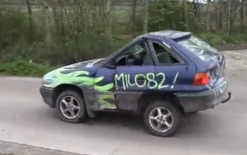Changes to safety ratings

Safety ratings published on Rightcar.govt.nz now focus on the impact vehicles have on all people involved in crashes on New Zealand’s roads.
Waka Kotahi hopes the change, which was rolled out at the start of this month, will lead to a greater improvement in safety and help to cut the number of people who die or are seriously injured.
To standardise the way safety-rating information is presented to the public, the used car safety ratings (UCSR) and vehicle safety risk ratings (VSRR) are now using “overall safety” as the primary measure.
The transport agency says this calculates the safety of a vehicle for its own occupants and all road users in the event of a collision, including people in other cars, pedestrians, cyclists and motorcyclists.
The overall safety rating is also being used for safety ratings published on third-party websites, such as Trade Me.
Previously, driver safety was used as the headline rating for UCSR ratings, which only measures the protection a vehicle offers to its own occupants. Driver-safety ratings will continue to be published by Rightcar for both UCSR and VSRR ratings, so people can find out how well a certain model will protect them in the event of a crash.
In addition, other road-user safety information is published to show the impact of a collision on occupants of other vehicles, as well as cyclists and pedestrians.
The Rightcar update includes an annual ratings update, with the latest ratings for all vehicles in New Zealand that have been assessed by Monash University’s accident research centre in Victoria using a database of eight million crashes.
Since the ratings measure the relative safety of vehicles compared to all others on the road, the ratings for some vehicles in New Zealand changed on December 1 to reflect that newer and safer vehicles continue to enter the fleet.
Safety label campaign
An advertising campaign has been encouraging consumers to look for the safety-rating label when they buy their next vehicle.
The campaign uses footage from the television advert The Unsell and was slated to run on digital platforms until mid-December.
The label is designed to be printed by motor-vehicle dealers and displayed on cars for sale, providing consumers with simple information about safety performance.
When traders generate vehicle-fuel economy labels (VFEL) labels, they can automatically generate a safety label for display alongside the VFEL. This makes displaying a safety label and providing the current rating information “as easy as possible” for traders.
Waka Kotahi says consumer research shows that three-out-of-four consumers are looking for vehicles with high safety ratings, “so the safety-rating label can be used as a point of difference and a sales tool by dealers who are selling vehicles with high safety ratings and helping to keep people safe on our roads”.
The transport agency adds it is “continuing to encourage people to buy the safest, cleanest, most efficient vehicle in their price range”.
Indicative rebates and fees
Rightcar’s dealer resources look-up tool now shows the carbon dioxide (CO2) emissions and indicative fees or rebates dollar values for CO2 ratings that will apply in 2022 – subject to legislation being passed.
“We’re sharing this indicative fee/rebate information to help you choose cleaner vehicles to import before the rule change in 2022,” says a spokesman for Waka Kotahi.
“We’ve also standardised the CO2 values across the Rightcar website using the World Harmonised Light Vehicle Test Protocol’s CO2 values.”





